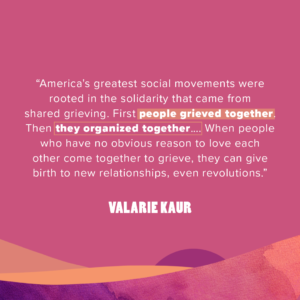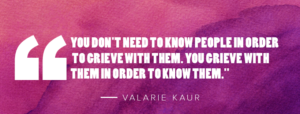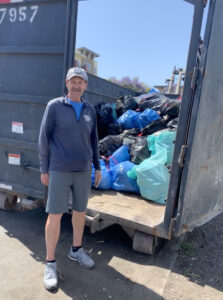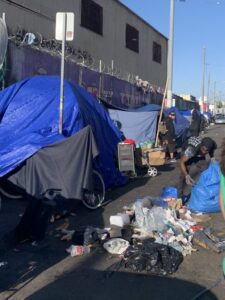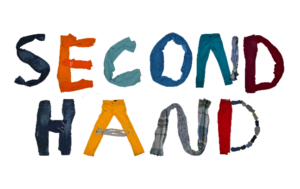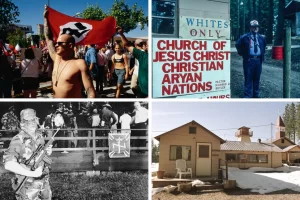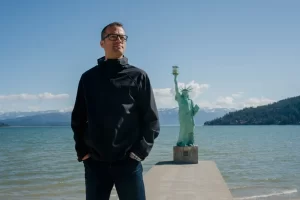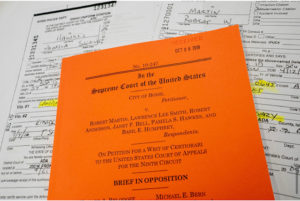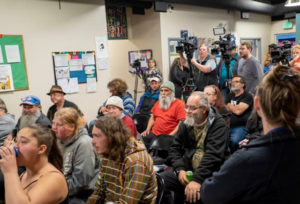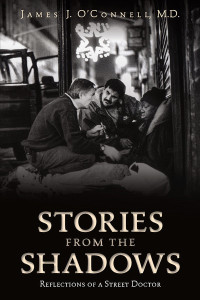homeless
Saturday, May 21, 2022
May 21, 2022To solve humanity’s problems, we need well-functioning brains…eating and living well with kindness and awareness…always compassion…building our brain architecture.
Tending body is tending to the self, and tending to the self is tending community, tending community is tending country.
[On Being]
J
O
Y
“The joy of life is to put out one’s power in some natural and useful or harmless way.”
-Oliver Wendell Holmes
Valerie Kaur
Oh my loves.
“They’re going to keep killing us.” This was my first thought after the news broke about the shooting at a grocery store in Buffalo. Terror and fatigue.
I’ve organized around white supremacist hate for 21 years, since before this gunman was born. The killings have become more frequent, more effective, and more efficient at taking life. I got the news while working on a memorial video on the white supremacist mass shooting in Oak Creek 10 years ago, revisiting all that pain. How to feel fresh grief when we are already in grief? How does the heart expand, instead of shut down?
Revolutionary love is the choice to labor for others, opponents, and ourselves. What is your role right now?
Will you focus on others? Grieve with Black people, show up to local vigils and gatherings, listen to the stories, fight for anti-racist policies, build new relationships of solidarity. Do one thing in your sphere of influence — your school, workplace, house of worship, or home — to stand in love.
Will you focus on opponents? The gunman cited “replacement theory” in his manifesto, a theory that nearly one in three Americans believe. Reach out to the colleagues, neighbors, relatives in your life who subscribe to this dangerous and racist belief. Open a channel for deep listening, share stories, stop the spread of misinformation.
Will you focus on your body and your people? If you can feel how this shooting touches trauma in yourself and in people you love, this is the time to make space for healing. Grieve and rage, wail and scream, rest and breathe. Be with people who make you feel safe. Let in softness and love into the places that ache. Together, we survive this. {And what is yet inevitably to come. -dayle}
[1,000,000 + have died from COVID. 1 in 3 U.S. citizens believe the plague has ended. It has not.]
More from Valerie:
Where do you notice feeling grief in your body? What is the quality of that grief? What is the shape of grief inside of you? If it feels uncomfortable, take another deep breath and stay with it. Breathe through it.
What does your body need to be brave with this grief? What do you need to feel it and to move through this energy? What rituals are you called to? Who do you need by your side.
Who have you not yet grieved with? Whose story have you not fully let into your heart? What community’s struggle have you not fully taken in? Notice what is happening in your body. If your fists tighten, or your heart beats fast, or if shame rises to your face, it’s okay. Breathe through it. Trust that you can. The heart is a muscle: The more you use it, the stronger it becomes. You don’t need to know people in order to grieve with them. You grieve with them in order to know them.
What do you need to do to be able to grieve with them? What vigils or marches need you? What houses of worship are you ready to visit? What phone call are you ready to make? You can begin where you are, with a simple text or email, saying to someone “I’m here for you.”
How to be brave with your grief.
https://valariekaur.com/2022/04/how-to-be-brave-with-your-grief/
“Loving someone means that one day, there will be grieving. They will leave you, or you will leave them. The more you love, the more you grieve. And so I invite you to honor your grief: it’s a sign of how deeply you have loved.”
-Valerie
Community, then country.
Coronado Times
Meet Brian Trotier
Triangle Project, located in the East Village of San Diego, just across the bay.
“The Triangle Project is a pilot program created to help improve the lives of unhoused people. Brian has been helping out in this area for about fifteen years and has developed relationships with many of the residents. A huge issue has been the trash in the area. The residents, mainly living in tents, don’t have a place to dispose of their trash which is unsightly, unsanitary, and demoralizing for them. Richard Aaron Horton, 64, a longtime resident, started improving the area by picking up trash. Brian Trotier knows Richard well and has expanded the effort by securing funding from the Lucky Duck Foundation. This local foundation focuses on the homeless and has contracted with EDCO for a dumpster to collect the trash.
The concept is simple, and the results so far have been amazing. Brian reported that, as of last week, the Triangle Project had collected in the previous 20 days, 3,794 bags of trash weighing a total of 23.89 tons. It is likely that much of this, including plastic, would have found its way into our bay and ocean. Here is how it works: every Monday and Thursday, EDCO drops off a dumpster at 8 am. Brian brings bags, gloves, and a stack of cash. Volunteers walk around the area greeting residents and asking if they’d like trash bags. For almost all, the answer is an enthusiastic “yes!” Residents get to work cleaning up their neighborhood. For every full bag of trash they bring to the dumpster, Brian gives them $2. The roughly two-block area goes from being very littered to being very clean within an hour.”
“riangle Project’s results are about double what Brian and Lucky Duck projected, and the benefits have gone far beyond a cleaner neighborhood (and bay). Residents express appreciation for being seen; they get along better with each other. “They have a common enemy—trash,” Brian acknowledged.”
“Keeping the Earth clean. That’s what’s happening in the long run. It’s a domino effect.”
https://coronadotimes.com/news/2022/05/18/meet-emerald-keeper-of-the-month-brian-trotier/
The Independent
My Carbon Footprint: the rise of the nearly new
by, Kate Hughes
“So often, being more eco is inaccurately pinned to greater cost, when actually – especially when it comes to everyday buying decisions – the opposite is true.
This widespread, if subtle shift in the way we shop, including the disintegration of the stigma around nearly new, vintage, and preloved may well have some relationship with the climate crisis but make no mistake, this is largely financially led.
What I love about second-hand too, is that it doesn’t preclude us from layering up further planet and cash-saving approaches.
When the old boy on our street moved into a retirement flat the neighbours bought his lawnmower off him. There’s now one lawnmower between five households, saving space, cash and helping maintain and develop lines of local communication and a sense of community.
More than four in 10 of us gave goods away for free locally in the first few months of the year, while half donated products to charity and more than a third even made financial donations despite experiencing hardship.
Free stuff – everything from haircuts to sofas are also on the rise, the site reports.
So go forth and embrace the charity shop, the quirky apps, the leviathan websites.”
HuffPost
Living With The Far-Right Insurgency In Idaho
A radical GOP faction, in open alliance with extremists, is seizing power and targeting its opponents with cruelty.
Some wonder: Is it time to leave? (Yes. It is.)
Jennifer Ellis, photographed in her home on April 3, 2022, created Take Back Idaho to push back against the right-wing, extremist views and tactics that have dominated the state’s politics.
‘A lot has been written about both the radicalization of the Republican Party and the decline of democracy in the U.S. — about the country being at a precipice. It’s maybe easy for those warnings to become background noise, or to dismiss them as doom-mongering pieces of clickbait. But in Idaho, the nightmare scenario is crossing into reality, as an authoritarian GOP sets about to create a whiter, Christian nation.
These MAGA radicals have gestured at the future they want: no rape and incest exceptions to Idaho’s abortion ban; no emergency contraception; no gender-affirming health care for minors; the banning of books; the jailing of librarians; and maybe no public education altogether.
I recently spent a week traveling across the state, from Sandpoint in the northern panhandle down through the green slopes and whitewater of Hell’s Canyon to the plains of Ada County, and then across lava rock and sagebrush to Blackfoot. In all these places, Democrats and more moderate Republicans view Tuesday’s primaries as an existential affair. Some are considering leaving the state if MAGA extremists consolidate more power. Others are digging in their heels.
The people I talked to were not all that accustomed to alarmism, which made it striking to hear some of their voices tremble when they talked about what’s happening to their home. Their message for the rest of the country? It’s gonna get bad. The GOP really will go that far.
“They have completely rebranded what it is to be a conservative here in north Idaho, and they have literally excommunicated and cleaned house of any rational, regular conservative from their ranks.”
– Shawn Keenan, local Democratic activist
“As much as I want to point to examples of their adverse impact on the legislative process — and there’s many things to point to — part of me, the social scientist in me, the military veteran in me, wants to, you know, not just hate the player, but hate the game,” said Mathias, who served in the Coast Guard and has a Ph.D. in public policy.
A grading system like the Freedom Index makes the often inscrutable process of legislating more accessible to voters, Mathias said, and the IFF is an outrageous arbiter.
Mathias is intimately familiar with the group. Last spring, he watched state Rep. Ron Nate (FI Score: 97%) and other far-right legislators manufacture a racist moral panic about Boise State University indoctrinating students with “critical race theory.” (It was not.) Nate, using talking points lifted from an IFF white paper, argued for cutting part of the school’s budget.
Mathias says he typically likes to “keep his powder dry” in the statehouse — Democrats are such a minority there, it’s not worth the fuss to debate every proposal — but in this case, both as the only Black man in the legislature and as a Boise State alumni, he felt compelled to speak.
Going to Boise State on the GI Bill, he told his colleagues in a speech on the House floor, pausing to fight back his emotions, “provided opportunities I’d never seen in my life. It changed my life.”
Critical race theory, he continued, simply recognizes that there are institutional biases — in “housing, health, education, wealth, income,” Mathias said — that have existed since our country was founded. “People of color always come out on the losing end,” he added, his voice breaking. “Always. And I don’t think it’s unfair to acknowledge it.”
Across Idaho, the far right has laid siege to nonpartisan positions, some of which require specific expertise, and made them partisan, installing loyalists with sometimes disastrous results.
A recent Vanity Fair piece, for example, profiled members of the national neoreactionary movement, acolytes of a philosopher named Curtis Yarvin, who is a close ally of billionaire Peter Thiel. This movement, which has buy-in from powerful GOP figures, is explicit about wanting to usher in the end of democracy by purging the current government of its enemies and establishing one-party control — or, put another way, authoritarianism.
J.D. Vance — the venture capitalist and “Hillbilly Elegy” author who recently won the Ohio Republican primary for U.S. Senate — is a follower of Yarvin’s. He positively likened this prospective purge to the deadly “de-Baathification of Iraq.”
“I think Trump is going to run again in 2024,” Vance told Vanity Fair. “I think that what Trump should do, if I was giving him one piece of advice: Fire every single mid-level bureaucrat, every civil servant in the administrative state, replace them with our people.”
Vance and Trump might look to north Idaho for inspiration.
“We’re losing here. We’re losing our state. We’re losing our town. … It’s just becoming overwhelming.”
– Sandpoint Mayor Shelby Rognstad
Full report:
https://www.huffpost.com/entry/far-right-idaho_n_628277e2e4b0c84db7282bd6/amp
New York Lands in Boise
December 3, 2019“Dawn Whitson, a shelter resident making $12 an hour as a hotel receptionist, said she wanted to know why the city was spending potentially hundreds of thousands of dollars to fight the suit instead of putting the money toward more shelter beds or homeless services.”
NYTimes
How Far Can Cities Go to Police the Homeless? Boise Tests the Limit
A decade-old legal fight shapes a mayoral race and offers the Supreme Court a chance to weigh in.
BOISE, Idaho — During a recent mayoral debate at a Boise homeless shelter, after disposing of icebreakers like the candidates’ favorite Metallica album, the moderator turned to something more contentious: a decade-old lawsuit, now a step away from the Supreme Court. The case, Boise v. Martin, is examining whether it’s a crime for someone to sleep outside when they have nowhere else to go.
The suit arose when a half-dozen homeless people claimed that local rules prohibiting camping on public property violated the Eighth Amendment protection against cruel and unusual punishment. The plaintiffs prevailed at the appellate level last year, putting the city at the center of a national debate on how to tackle homelessness. Now Boise — after hiring a powerhouse legal team that includes Theodore B. Olson and Theane Evangelis of Gibson, Dunn & Crutcher — has asked the Supreme Court to take the case, a decision that could come within days.
Nobody at Interfaith Sanctuary, a shelter for 164 with bunk beds in neat rows, needed a primer. They had been talking about it for weeks. Before the debate, Dawn Whitson, a shelter resident making $12 an hour as a hotel receptionist, said she wanted to know why the city was spending potentially hundreds of thousands of dollars to fight the suit instead of putting the money toward more shelter beds or homeless services.
In the course of the one-hour event organized by the shelter, the two candidates, competing in a runoff election on Tuesday, heard plenty more about the issue. One person said there was a misconception that all homeless people are drug addicts. A veteran said he had $771 left over from his disability check each month but couldn’t find a room for less than $500, and asked what he was supposed to do.
Even before the answers, everyone knew who the room was for. Lauren McLean, the City Council president and top vote-getter in an inconclusive November election, opposes the city’s quest for leeway in policing the homeless. She says the solution should come from tackling poverty.
“Each of us, no matter our situation, has to sleep,” she said. “We need more beds. We need to create homes for our residents.”
Her opponent, Mayor David Bieter, seeking his fifth term, was unapologetic about fighting the lawsuit, despite the shelter crowd. Echoing the position of various Western cities that support Boise’s stand, Mr. Bieter argued that the ability to issue citations for sleeping outside is a little-used but necessary tool to keep homelessness in check.
“I’m really concerned when I see Seattle or Portland or San Francisco,” he said. “I go there and I see a city that’s overwhelmed by the problem, and people tell me all the time, ‘Don’t allow us to be like those other cities.’”
On the surface, Boise, a city of about 230,000 whose modest downtown does little to obscure the mountain views, is an odd point of origin for such a debate. Its annual homeless counthas found about 50 to 100 unsheltered people for the past seven years. A drive around town turned up a handful of people sleeping outside, a far cry from the blocklong tent cities in California.
But the city’s decision to appeal Boise v. Martin has elevated homelessness to a focus of an increasingly ugly campaign. Third-party mailers have put Ms. McLean’s picture next to a homeless encampment with the words, “Lauren McLean’s Future Boise.” She recently posted on Facebook that someone in a pickup truck was putting tents and sleeping bags next to “McLean for Boise” yard signs.
The city’s relatively modest homeless problem is cited by both candidates to bolster their positions. Each is essentially campaigning on the idea that rapid growth needn’t produce streets of destitution as it has in California — but the two diverge on the role that law enforcement should play.
To Mr. Bieter, the homeless crises in Los Angeles and San Francisco prove that the city’s power to issue citations and shoo sleeping people off sidewalks is needed to prevent larger camps from forming.
Ms. McLean calls for a different approach. “I think other cities got to the point where it was too late,” she said in an interview. “So let’s say right now we’re actually going to get to work to prevent homelessness instead of hanging our hat on getting the right to ticket people.”
The road to the Supreme Court’s doorstep began in the office of Howard Belodoff, a Boise civil rights lawyer. In 2009, after a local shelter closed, Mr. Belodoff filed a federal lawsuit on behalf of six homeless men and women who had been cited for violating city ordinances that prohibit sleeping on public property. Most of the plaintiffs were prosecuted and pleaded guilty, with the exception of Robert Martin, whose case was dismissed.
Mr. Martin and the other plaintiffs subsequently filed suit challenging the constitutionality of the city’s ordinances. The case was litigated for several years before being appealed to the United States Court of Appeals for the Ninth Circuit. Last year, in a decision that reverberated across the West Coast, the court ruled that it was unconstitutional to cite someone for sleeping outdoors if there wasn’t any shelter available.
In August, Boise formally asked the Supreme Court to hear the case. While the Ninth Circuit has described its decision as “narrow,” the city’s petition portrays it as anything but, using words like “vast,” “far-reaching” and “catastrophic” to depict a picture of mass confusion and lawlessness arising from the court’s ruling. The filing goes on to say that the Ninth Circuit’s ruling could also imperil a host of other public health laws “such as those prohibiting public defecation and urination.”
“Public encampments, now protected by the Constitution under the Ninth Circuit’s decision, have spawned crime and violence, incubated disease and created environmental hazards that threaten the lives and well-being both of those living on the streets and the public at large,” it declares.
In an interview, Ms. Evangelis, from Gibson Dunn, said: “I don’t think that fighting for someone’s right to live and die in squalor is helping.”
In response, lawyers for the plaintiffs, quoting an earlier Ninth Circuit decision, argue that the court’s ruling in the Boise case merely “reflects the ought-to-be uncontroversial principle that a person may not be charged with a crime for engaging in activity that is simply ‘a universal and unavoidable consequence of being human.’”
Dozens of cities have filed briefs backing Boise’s position, saying that they are confused as to how broadly the Ninth Circuit ruling applies and that the decision has impeded enforcement of basic health and safety laws. In some cases, the cities contend, the decision has actually made it harder to build housing meant for the homeless.
Among Boise’s allies is Los Angeles, which has passed more than $1 billion in bonds for permanent supportive housing but has found steep neighborhood resistance. Mike Feuer, the Los Angeles city attorney, said the Ninth Circuit decision raised as many questions as it answered. For instance, to determine whether or not is in compliance with the ruling, does the city have to constantly count how many beds there are and compare it to the homeless population? Can Los Angeles prohibit sleeping in sensitive locations, such as next to new homeless shelters?
“The language, rather than citing clear principles where constitutional questions are at stake, makes local jurisdictions vulnerable to lawsuits as they struggle to achieve a balance between the legitimate rights and interests of homeless people and the legitimate rights and interests of other residents and businesses,” he said.
Whatever happens in the Boise mayor’s race, Boise v. Martin is far enough along that its fate now rests with the Supreme Court: Even if she is elected mayor, Ms. McLean said, she has no plans to withdraw from the case. “The case is moving forward — that ship has sailed,” she said. “I just still maintain that we can do this without ticketing folks and moving them into the criminal justice system, which will make it harder to find shelter, home and work.”
#
Compassion among the homeless.
September 30, 2015NPR/Fresh Air
Tues., Sept. 29th, 2015
http://www.npr.org/templates/transcript/transcript.php?storyId=444214320
In this excerpt, Dr. O’Connell shares a story of a homeless woman, in need of a liver transplant, who makes an unusual, and tender request:
“Stories From The Shadows: Reflections Of A Street Doctor.”
GROSS:You have treated a lot of patients who have died – not necessarily died under your care directly, but eventually died from living on the street. And you write about how some of the shelters do funeral services or memorial services. And I would like you to describe one of the funerals that you’ve attended for a homeless person who you treated that you found especially moving.
O’CONNELL: One woman who was from the streets who used to describe herself as a bag lady. And she would keep you and I away by having just the smelliest clothes she could. And her belongings were smelly, and she would put those around her so that it would protect her from anyone coming near her. And she developed – she drank and had gotten hepatitis C from a blood transfusion many years ago, and she needed a liver transplant. And it turns out if you’re homeless, you have a very hard time getting a life-saving liver transplant unless you can show at least six months of residential stability and at least six months of being clean and sober. So we kept her in our facility for that time so that the transplant surgeons could have the documentation they needed. And I remember just before she was at the top the list, she called me over one Sunday morning and asked if I would take her picture. And I was not used to taking pictures of people’s faces at that time. I used to take pictures of, you know, feet – frostbitten feet, et. cetera – that I can use for teaching medical students and residents how to handle some of those problems. But I took a picture and brought it back to her. She got all dressed up – put on a dress, put lipstick on, tied her hair up. She had a Styrofoam cup in which she put some flowers and put it next to her bedside table. And I took the picture, and I brought it back to her a couple of days later in a little frame and asked her what was going on. And she told me that she was facing this major liver transplantation, didn’t know whether she’d live or die, but that she had not seen her daughters – two daughters – since they were 4 and 5 years old, and that was 25 years ago. And she wanted to be sure there was a picture of her in case her two daughters wanted to look and see what their mother – what had happened to their mother someday, and she wanted to be presentable. So I was blown away mostly because she was telling me – I think in graphic ways – what it’s like to experience illness, suffering and the specter of death when you are homeless and have lost everything. And what I have learned about homelessness in our city and I think across America that it is about as lonely a situation as you can have. People are alone, ignored, kind of abandoned. And I think when they face death, they look at their lives and wonder, you know, what could’ve been – think about what could have been, wonder about stuff. And I shudder every time I think about what that must be like to really have lost even touch with your own children, have no family members, have no money and really no hope for a future that looks any better than living on the streets. But anyway, what was striking to me is when I came back into – I gave her that picture when I came back to – our McInnis House is what we call it – I think there were 22 people the next day that asked me to take their portraits. And it’s…
GROSS: You have a lot of these photos in your book. Is that – so this is how you started doing that?
O’CONNELL: That’s exactly how I started doing it. I was always – I thought it was being kind of voyeuristic to take pictures of homeless people. I didn’t want to take advantage of the privilege I had of being in their lives to also take pictures, so I was kind of – it’s all upside-down from what I would’ve once thought. But that was a long-winded way of saying that death – when people die, we really try hard to mark their death and to gather people around and celebrate and memorialize these folks. Many, as you know, we don’t know where their families are. We don’t know if that was even their real name. And when they die, they’re in the morgue – the city morgue – until someone claims them. And if no one does, then they will be buried in a pauper’s grave somewhere in the city, so we try hard to not only one – try to find the families – but two – if no family is found, make sure we have a memorial and mark the burial and passage of that person. And it’s the other homeless people who really cherish and value that.
GROSS: So let me ask you, this – this photo that got you started taking pictures of the homeless patients that you treat, she wanted the photo taken so if she died, her daughters who she had lost touch with would see what their mother looked like.
O’CONNELL: Yes.
GROSS: Did anyone come looking for her?
O’CONNELL: No one ever came.
GROSS: That must have made you sad.
O’CONNELL: It did. It was really sad.

